Concerning the Spiritual in Art
There are lots of reasons to admire Amanda Yates Garcia, The Oracle of Los Angeles, but I think the one that speaks to me the loudest is the way she answers questions of the form
Does X really work?
Or
Is Y really true?
Crap I want to talk about today
Before describing how Amanda Yates Garcia answers these questions, I should note that this may turn out to be a long and convoluted discussion. Before I start I’d like to convince you that I actually do have some point and that this is actually going somewhere. The name “Wassily Kandinsky” will not come up explicitly in this text. But I’m sure he’s in here. Here’s an outline of what will come up:
- Amanda Yates Garcia (efficacy)
- Glenn Zucman (breathing underwater)
- Stacey & Jenny (Ouija adventures)
- Lee Le (automatic drawing)
- Daniel, Christof & Francis (philosophy & science)
- Teal Swan (there is no tarot deck)
- Anon PhD Candidate (willingness to believe)
- Jun Yin Axup (Occam’s Razor)
- Kiyomi Fuki (social practice: tea)
- Brian Davis (social practice: juicing)
1. Amanda Yates Garcia (efficacy)
Amanda Yates Garcia explains that as a Witch, it isn’t her job to know if a particular crystal uniquely holds energy in some molecular form, or ionizes something, or has unique atomic properties. Her job is to know what works. And time after time she’s seen that crystals and tarot cards and spells do “work”.
Garcia asks if a dollar bill “works”. It is, after all, a simple scrap of paper with roughly zero intrinsic value. Yet because of the perceived value we collectively attribute to it, the dollar bill becomes not only powerful, but something to live, and sometimes die, for.
Whether the crystals, tarot cards, and other tools Amanda Yates Garcia uses are unique materials in some special molecular way, or objects that offer some rare access to some non-material supernatural realm, is not her concern. That they can help answer questions and solve problems for real people, is.
I have much less experience than Garcia, but in the experience I do have, I think she’s right.
We are a primitive species still crawling out of a cave and toward the light. We are a hi-tech species innovating powerful new tools at an always accelerating pace. You might wonder if the Muslim who acquires a new, hi-tech GPS Prayer Mat that allows heretofore impossible precision in aligning your prayer mat toward Mecca might have a meta-moment and wonder if aligning a prayer mat really mattered. Or an even more meta-moment and wonder if prayer really mattered. In Glenn’s brain the very concept of a GPS Prayer Mat seems to render the idea of prayer obsolete. Most of us don’t ask these sorts of questions. We just pray better.
2. Glenn Zucman (breathing underwater)
Years ago I used to have a recurring dream of breathing underwater. Or actually of being trapped underwater. I say “trapped” because there was always some sort of horizontal object that prevented me from swimming to the surface. “Trapped” is the right word, but also misleading. I experienced none of the stress or terror that being trapped often comes with.
This was for me a very calm experience. A calm dream. I simply took in a big mouthful of water and in some fishlike manner, I’d strain the air out of the water and breathe.
I didn’t have this dream often, only once or twice a year. But it recurred over many years.
Once I learned to scuba dive, I never had the dream again. It was as if diving in the real and physical ocean was an even better and richer experience than the dream had been, and once I dove in that ocean the dream became obsolete.
Unnecessary.
I’ll come back to my dream of breathing underwater after I get to the part about Lee Le and I inventing automatic drawing.
3. Stacey & Jenny (Ouija adventures)
A long time ago at a university apartment far, far away, my friend Jeff Obrow had an Academy Awards watching party.
Late that night, after the awards show was finally over, Jeff asked, wouldn’t it be fun to play with a Ouija board. I might have been a little relieved when he couldn’t find the Planchette. (marker thingy that moves over the letters on a Ouija board so you can pick out which letters are being selected)
Then Jeff wondered, “Would a coffee can lid work?” So he took a round, plastic coffee can lid, cut an awkward hole in the center, threw a bit of baking powder on the board, and it was off.
I’d never used a Ouija board before, had no idea if they really worked, and was definitely unimpressed by the crappy coffee can lid pretending to be a planchette.
Then Jeff’s girlfriend, and my good friend, Stacey Giachino, and I laid our hands on the makeshift planchette. The best word I can think of to describe what happened next is
Magic!
Over the years since that night I have not use a Ouija board very often. But it comes up from time to time. About half of those times nothing very interesting happens. The other half,
Magic!
Once I took a Ouija board over to Jenny’s house. We sat facing each other, cross-legged, knees touching, with the Ouija board perched atop our legs.
Four hours later my legs were cramped and I desperately had to pee. But I didn’t dare stop the session because the questions Jenny was asking were so deep and fundamental for her, and the answers she was receiving were so powerful and essential, that I knew it was just something I had to help her with, or assist, or bear witness, in any way I could.
The question that seems to invariably come up with Ouija boards is if the other person is pushing it or not? I suppose this is something like asking Amanda Yates Garcia if crystals really work or if tarot cards are really true.
Because of my relationship to people like Stacey and Jenny, and the power of the messages, I just knew that this was a non-issue in these cases. Nobody was pushing the planchette. At least not consciously.
It also didn’t hurt any that on occasions like these the planchette tended to move so decisively and with such dramatic speed that it was hard to keep up with it! Our hands would often be too slow to keep up and fall off. We’d have to race to catch up to where the planchette was going.
4. Lee Le (automatic drawing)
One night Lee Le and I were playing with a Ouija board and we had a unique experience.
I could simply categorize most of my Ouija board experiences as either dramatic, like the ones with Stacey and Jenny, or uneventful, like a handful of other experience where the lazy planchette never does much of anything.
The experience with Lee was different.
The planchette was plenty inspired, it danced freely and with rhythmic inspiration across the board.
But it never spelled anything.
In fact it never really stopped on any letters at all. So there wasn’t even the chance of it spelling something in a different language.
In a dramatic reading like the one with Jenny, there was a lot on her mind, her heart and her soul were just so heavy with questions.
In a silly reading like the one with Noelle and her friends, perhaps there was never the concentration or focus to bring anything to the fore.
Perhaps with Lee there was an intensity of presence, but no burning questions to be answered. Perhaps that intensity manifest itself as a dance, but not as text.
It occurred to me that since the planchette was dancing nicely, but not using text, that the Ouija board with its alphabet was superfluous. I replaced the Ouija board with a drawing board on which I’d taped a luxurious sheet of Rives BFK paper. I replaced the planchette with a stick of graphite.
Lee and I placed our hands on the graphite and it instantly and effortlessly began to draw. The graphite discovered large, sweeping drawings. Geometric. Tremendous circular power.
That night Lee and I invented Automatic Drawing!
Over the next month or so Lee and I made a couple dozen automatic drawings. Each was a beautiful piece in itself, and as a collection they became a trace, or documents, of moments together.
Later I did a bit of research and was just a little disappointed to learn that Lee and I hadn’t exactly invented automatic drawing. That people had been practicing it for centuries. But it was still an amazing experience.
More about Ouija boards, and breathing underwater, in a moment, but first I should say something about Christof Koch and reductionist biology.
5. Daniel, Christof & Francis (philosophy & science)
I audited a couple of classes at CalTech from neurobiologist Christof Koch. We became friends and through Christof I also came to have conversations with his research partner Francis Crick and philosopher Daniel Dennett.
Back at that first Ouija board experience, when Jeff introduced the board, and then just as Stacey and I were starting to use it he added,
Oh, by the way, you lose your immortal soul if you use this
I suppose it was supposed to be funny. It wasn’t. I found it a little annoying. And yes, a little scary. And I suppose that was the point. To make it a bit of a liminal experience. To heighten awareness. Seriousness. Focus. And I guess it did that.
Over the years I’ve had dramatic Ouija experiences with people like Jenny. But I’ve never believed that the board was a portal to some alternate, spiritual dimension. I’ve never believed that the planchette was being moved by some invisible spirit and that our hands were just along for the ride.
Oh by the way, on that 1st Ouija experience with Stacey, the invisible spirit that I might have believed in then but don’t believe in now told us that its name was “Tausi”.
The classes I took from Christof, and the conversations with Crick and Dennett, were about the neurobiology of vision. But along the way I became a reductionist biologist.
Or I should say I came to believe in reductionist biology. I flunked out of the math-science death march ages ago and I’m hardly any kind of scientist. No biologist, microbiologist, neurobiologist, or any other kind of scientist am I.
The overly-simple description of ideas on existence is that you are either a dualist or a materialist. For dualists there is a physical realm that can be touched and measured, and a spiritual realm that is inaccessible to the physical. For materialists there is only the material. For materialists, science can, in the fullness of time, know everything. Answer all questions.
The fullness of time could be a long time! And it’s also possible that some aspect of universe, existence, or mind is so complex that the human brain is fundamentally incapable of understanding it. But at least in principle, everything is knowable and understandable from our material realm.
I don’t believe in Tausi.
I also don’t believe that Stacey, or Jenny, or I were ever pushing the planchette. What I do believe about a dramatic case like Jenny’s is that she was filled with deep and urgent questions, and that the board was a way for Jenny to access answers to those questions. Not because Tausi knew stuff and would tell her, but because Jenny knew stuff in ways that were not consciously accessible. And the board would help Jenny access the inaccessible within herself.
I think sometimes “Tausi’s” function is to let two subconscious minds join across the Ouija board in a conversation. A kind of exquisite corpse game for subconscious minds. Ultimately, Stacey and I are pushing the planchette! We just don’t know we are. We don’t mean to. It is a subconscious meditation or trance that we enter together and autonomically send the planchette to text-based ideas.
With Jenny, I don’t think I was important in the formulation of the actual answers. I think the answers came from within Jenny. My role that night was simply to be supportive and facilitating. The longed for, and deeply relieving, answers that Jenny obtained that night were already within her. Jenny’s answers weren’t in me and they weren’t in the board. And yet without me or the board, she might not have found those answers, at least not that night.
All these years I’ve still carried a tiny bit of resentment for the way Jeff contextualized the Ouija board so long ago. In recent uses of the Ouija board I don’t use any of his lose your immortal soul baggage, and have on a couple of occasions tried explaining the forces I believe to be at play. It is a long and boring explanation! Although I believe it to be true, I’ve even bored myself by the time I finish. On the couple of occasions I’ve tried this nothing interesting, or at all, has been said by Tausi or anyone else.
Jeff’s pronouncement may have been manipulative, but it was also effective. Just as we’ve all realized that while Stronger Together is ultimately a far richer concept, it is boring and uninspiring compared to the vapid yet more compelling Make America Great Again!
Perhaps I was technically correct, but I failed. Jeff may have woven a manipulative fiction, but he succeeded.
It’s a bit like when I write an essay or blog post. As I go through it I see all the simplifications and ways my ideas could be attacked. I account for this with a litany of caveats and qualifications. By the time I read that 1st draft it is so over-caveated and boring that it says nothing. In the next draft I take all the caveats out. It is now more simplistic and vulnerable to attack, but at least it says something. At least it has a point of view. At least it is clear and concise.
What I realize now is that since the night Lee and I “invented” Automatic Drawing, I have never had a productive Ouija board session. Could it be that like my long ago dream of breathing underwater, the Ouija board was a bridge to another place? That once I became a scuba diver, I didn’t need the dream? That once we discovered the power Automatic Drawing, the tedium of spelling out ideas one letter at a time was just too small and simple?
I still have the Ouija board. But I don’t know if I’ll ever use it again. I don’t know if I need it anymore.
6. Teal Swan (there is no tarot deck)
A few weeks ago, for reasons I already can’t remember, I became fascinated with the idea of Tarot cards. For my entire pre-December-2016 life I’ve barely even known they existed. I’ve certainly never paid attention to what they are or what you do with them. Without the occasional cheezy, melodramatic movie where someone puts down the Death card to overbearing music and we see a horrified querent recoil in fear, I might not even know Tarot existed.
Now it’s amazing how many hours I’ve spent at the Alexandria II bookstore in Pasadena, pouring over their endless supply of Tarot and Oracle card decks. And like any new thing you want to learn about, I’ve watched a bunch of YouTube videos.
Years ago, playing late-nite-TV-roulette at my parents house, I saw plenty of self-help hucksters. They were all ridiculous to me. The were all shameless scam artists to me.
Except Tony Robbins.
IDK if Tony Robbins message was fundamentally different from anyone else’s. Or if he had some sort of authenticity the others lacked. Or if I just liked the tone of his voice. All I do know is that when the others talked it was silly. When Robbins talked I felt good.
In my YouTube Tarot surfing I wound up watching a few Teal Swan videos. Swedish Wikipedia lists her as part of the New Age Movement, or New Age rörelsen. Swan’s own website calls her a Spiritual Leader in the field of Metaphysics. AKA The Spiritual Catalyst.
Like anybody who gets enough exposure online, Swan has loads of followers, and also plenty of haters. I didn’t spend enough time with her to assign any sort of 67% legit, 33% iffy grade to her. What I did find is that, haters notwithstanding, she had a quality that I connected with. Not exactly Tony-Robbins-like, but like Robbins, something about Teal Swan’s ideas, or at least her voice, resonated with me.
Most relevant to my pursuit at hand she said something important about Tarot and Oracle decks: that they are ultimately unnecessary. That they are tools for communication, but the insights lie ultimately within the querent. The tools are very helpful, but at some level of enlightenment, unnecessary. Like my session with Jenny, where the Ouija board was tremendously valuable, but the answers were within her. Or like the pilot episode for the Star Trek television spin-off Deep Space 9, where the reluctant Commander Sisko tries to ask the spiritual leader to make a pronouncement, but before he can ask she stops him with a hand in the air and ripostes,
I cannot give you what you deny yourself; look for solutions from within, Commander.
7. Anon PhD Candidate (willingness to believe)
I was at my favorite bakery on planet earth, Bake Code in New Taipei up the street from me on Valley Blvd.
Milk tea, hot. And a pastry.
On one of their high, community tables, I’d done a tarot spread and was writing the results as an eDivination post on my laptop. After a while the guy sitting diagonally from me asked if these were Tarot cards.
Yes.
Over the next 10 minutes or so he’d punctuate a few minutes of silence with another small question. Finally I recognized his level of interest and explained the spread I was working on and showed him the rest of the deck. I was working with my favorite deck, Ian Daniels’ Phantasmagoria: The Tarot of Vampyres. He was a little taken aback by the dark imagery! I find myself drawn to “dark” decks, not because I’m seeking “dark” readings, but because I feel that they give the fullest range of answers. Of ideas and emotions. Lighter decks, and especially lighter Oracle decks, seem to only go light, whereas dark decks seem to have the ability to say more.
Photographing human hair is a pretty different endeavour, but there’s a similar effect, though the polarity is reversed: in photographing dark hair, it’s hard to get any tonalities other than dark. Photographing blonde, or very blonde hair, you can get a full range of tones. You can get plenty of blonde highlights, but no matter how bright the hair, it will always fall in patterns that dance in the light and give a wide range of tones from light through all the midtones and definitely into strong shadow areas. I’m not here to pimp Barbie or Steve Bannon’s racist inclinations, but blonde hair is a joy to photograph.
As a pigment-based medium, I find that blonde hair gives the widest tonal gamut. As an emotion-based medium, I find that “dark” Tarot decks give the widest idea-emotion-answer gamut.
I explained to this Bake Code querent I didn’t expect to have that the cards could be read individually and also based on their position in a spread. And that a common, simple spread could be three cards: Past, Present, and Future. He dealt 3 cards for himself:
- Judgement, for the past decisions he didn’t feel he’d had the strength to make.
- 6 of Swords, I read as the intersectionality of Swords’ air, or language, or mind, with the harmony of the numerological 6. He thought this perfectly fit the action he’d avoided but needed to take.
- 10 of Wands, I read not as “struggle,” but as the success after struggle. As Wands’ fire, ego, charisma, and extroversion, meeting with numerological 10’s huge sense of fullness. The power at the end of the Wands suit. This would be his stronger position once he took the action that he knew he had to take, but was skiddish to go through with.
While his English was perfect, it turned out he’d only lived in the United States for the past 5 years, having been born and raised in China. Now a graduate student in a not too far away PhD program, he had to make a decisive change. But he thought this sort of bold action was only something Americans do, not something Chinese do. His conservative girlfriend, parents, and family all encouraged him not to rock the boat. Not to make the change that deep inside he knew he had to make to reach his future goals.
The 1st interesting thing about our over-an-hour of talking was that we only discussed the cards directly for a few minutes. Yet like Ouija boards, and the hammers that are so valuable in building houses, yet are not themselves a physical part of a house, the cards were the key to our conversation, his new insights, and his new resolutions. If I hadn’t been working with a Tarot deck, he’d never have spoken to me at all. And the three cards seemed to powerfully describe where he was, how he’d gotten here, and where he had to go. I told him to take a picture of the spread with his phone and carry it with him as part of his resolve. Like my session with Jenny, I don’t think I really gave him anything that he didn’t already have within, but it was trapped within in some sort of pre-cognitive state, and it seemed like the cards and I helped him understand and admit to himself what deep down, he probably always knew needed to be done.
The 2nd interesting thing was that his PhD was in Computer Engineering. Like my fictional Muslim using GPS to perfectly align his prayer mat to Mecca, this real-world querent was surprisingly happy to let his highly analytic doctoral degree program be guided by a mystical tool of divination. I was surprised that someone working on VLSI (very large scale integration of computer architectures) could so easily believe in a deck of cards. But he was a person with questions. A person in need. And the cards were a tool for him to come to the place of resolution he needed to reach but had found challenges in reaching.
8. Jun Yin Axup (Occam’s Razor)
All of these Ouija boards and Tarot decks are wonderful. With just one problem. When I use them I think of Jun, and then I feel guilty.
In all the time I’ve known Jun Yin Axup we’ve never spoken of Occam’s Razor at all. For at least a generation now it seems like everyone says Occam’s Razor. When I was younger I’d never heard the term Occam’s Razor, instead peeps used the less dramatic term Parsimony.
Occam’s Razor or Parsimony, here’s how Jodie Foster’s Ellie Arroway defines the idea in Robert Zemeckis’ 1997 film Contact:
It means that all things being equal, the simplest explanation tends to be the right one.
Jun and I have never discussed parsimony. Yet of the scientists I know, she strikes me as the most Neil-deGrasse-Tyson-ish. A scientist’s scientist. A pure scientist. I remember well our conversation about how engineers believed in god, but that scientists tended to be atheists.
When I say things like the planchette was inspired, I think of Jun and feel guilty. Why not just say that through the mutually held marker Lee and I established some sort of subconscious, or muscular, or meditative, or trance communication and we moved it in unison to create rhythmic patterns.
I guess that’s less parsimonious of words, but probably a more precise description of the experienced phenomenology.
Even if, you know, the planchette did “feel” inspired.
Teal Swan describes the Tarot deck as ultimately unnecessary. Like Commander Sisko, I believe that Jenny found her answers from within. But there’s no doubting how helpful that cheap fiberboard Ouija board was in her process. Even after 4 hours of it, Jenny begged me to continue. The conversation had been so fundamentally healing for her life questions.
Are Ouija boards and Tarot decks primitive culture? Artifacts? Remnants of our pre-technological existence? Or densely packed icons that let us speak in a powerful subconscious language? Like the neurolinguistic hacking in Neal Stephenson’s Snow Crash?
9. Kiyomi Fuki (social practice: tea)
And then there is Kiyomi Fuki, who serves people tea and calls it art.
10. Brian Davis (social practice: juicing)
And then there is Brian Davis, who juices for people and considers himself not a Robek’s or Jamba Juice employee, but an artist.
The artform of Social Practice may be a ways from mystical or divinitory practices like Ouija boards and Tarot decks.
Or maybe not.
In the hands of sensitive practitioners, Tea, Juice, Ouija, and Tarot are all forms of conversation. Forms of deep communication. Of healing.
I’ve heard Amanda Yates Garcia describe going to a Hollywood screenwriter party where she could so easily see each attendee gauging their relative status in the industry and calculate who should suck up to whom to achieve some sort of status upgrade. I may use a Vampire Tarot deck, but I’m confident there was more vampiric activity at that screenwriter party. A party where nobody had true fun. A party where nobody healed anybody.
As an educator I’ve seen students struggle with virulent conditions like depression. One of the best students I’ve ever had was locked in a struggle with bipolar disorder. I could daily watch her incredible sense of will and determination fight with her own brain. No one in that class worked harder. No one in that class tried harder. No one in that class was more on the edge of tears each and every day. She was a frail person, built of incredible strength and courage. Tea, Tarot, or just Faculty Office Hours, we are surrounded by people silently screaming for help. We can choose to hear those cries, or we can continue on in the numbness of unexamined, and unengaged, blissful ignorance.
Culture critic Hennessy Youngman describes Relational Aesthetics (Social Practice) as someone who spent too much time earning an MFA and not developing social skills, using their art practice as a way to do the things that other people just do normally.
Tea.
Juice.
Conversation.
Healing.
I imagine some distant, self-actualized future where we don’t need Tarot cards anymore. Yet so many of us in this century don’t seem to live there yet. And so far, even CE PhD candidates can still sometimes live a better life with a little help from the Six of Swords.
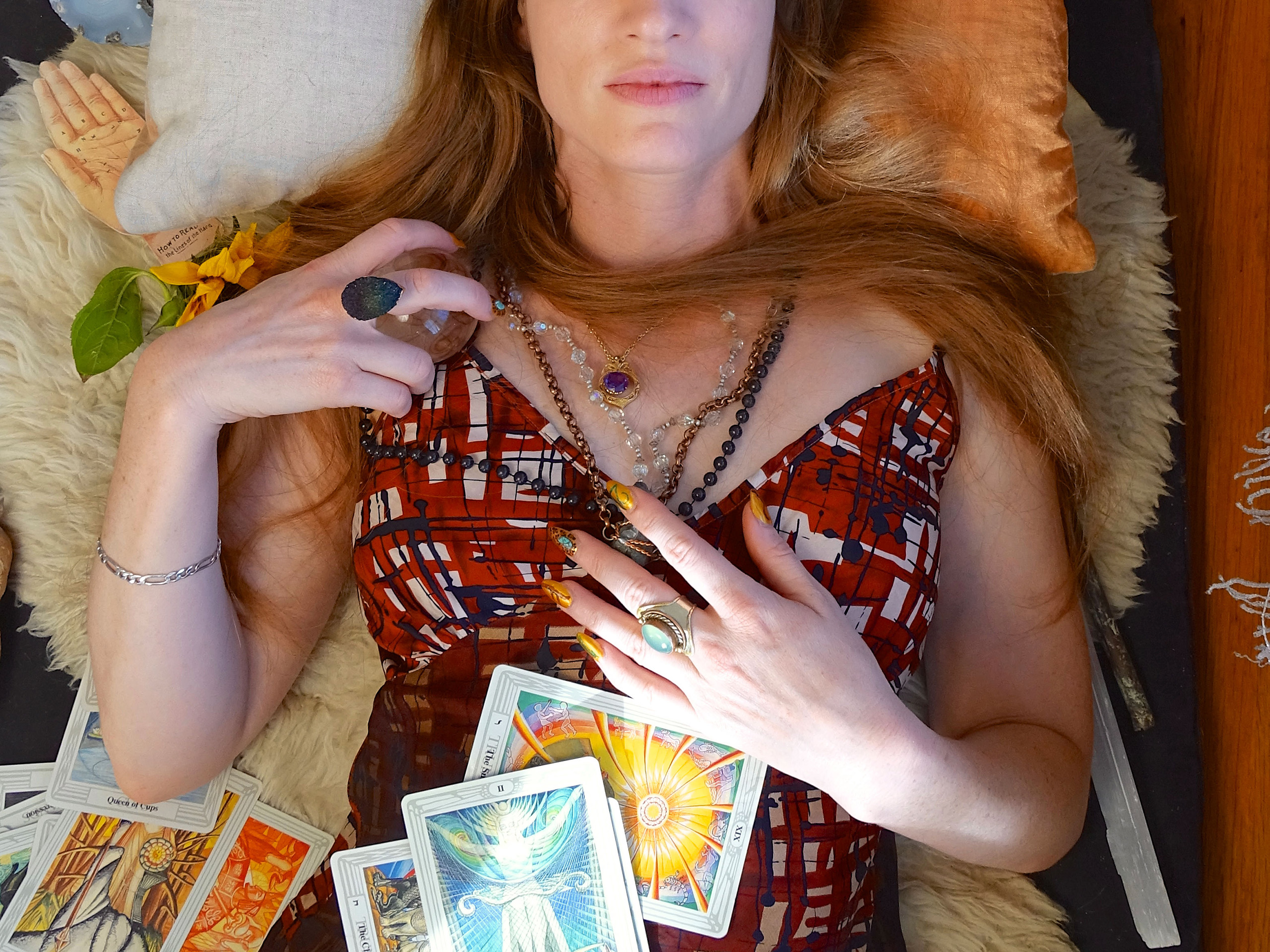
Amanda Yates Garcia, Oracle of Los Angeles
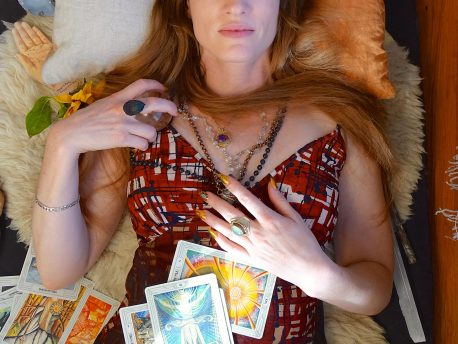
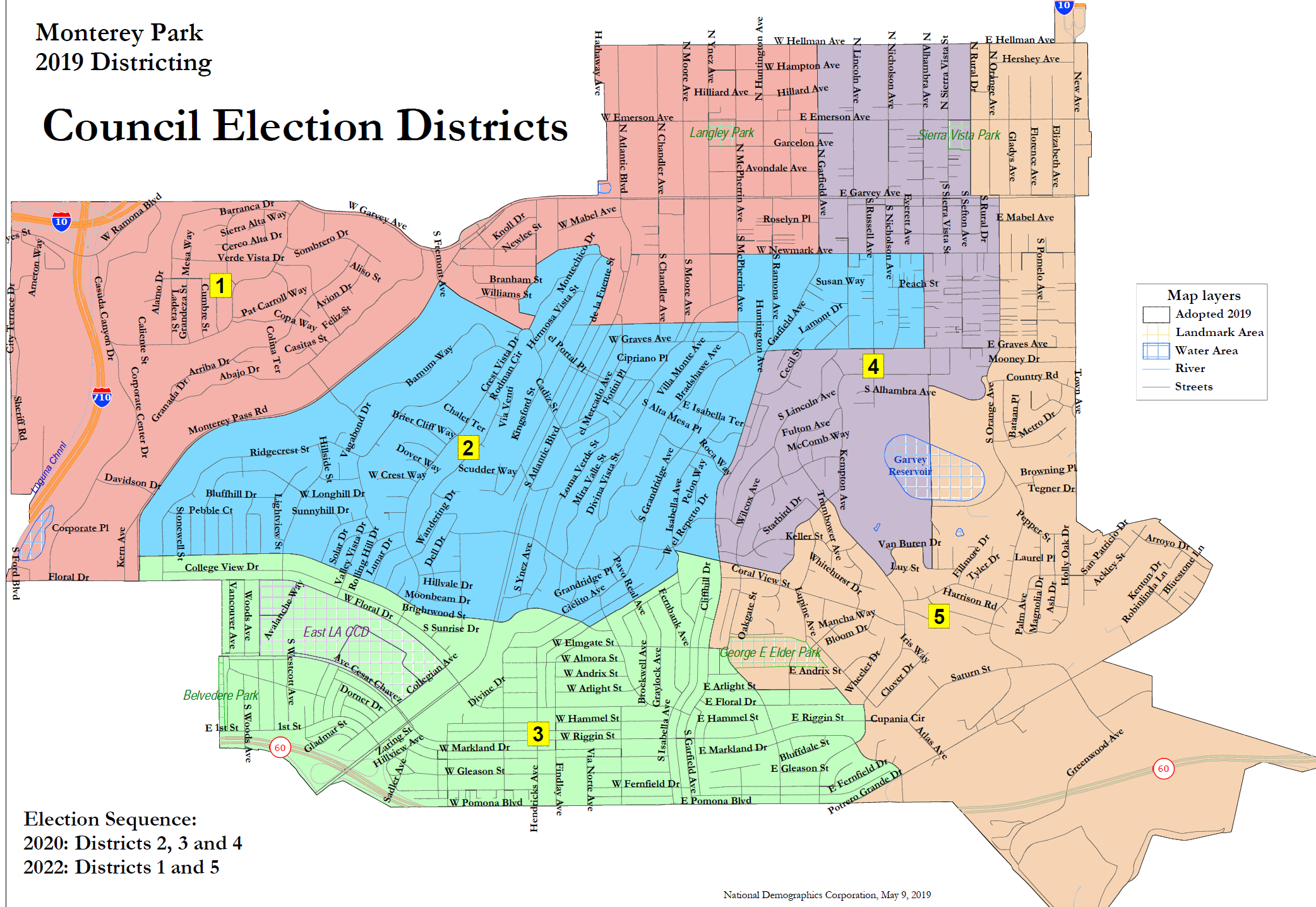
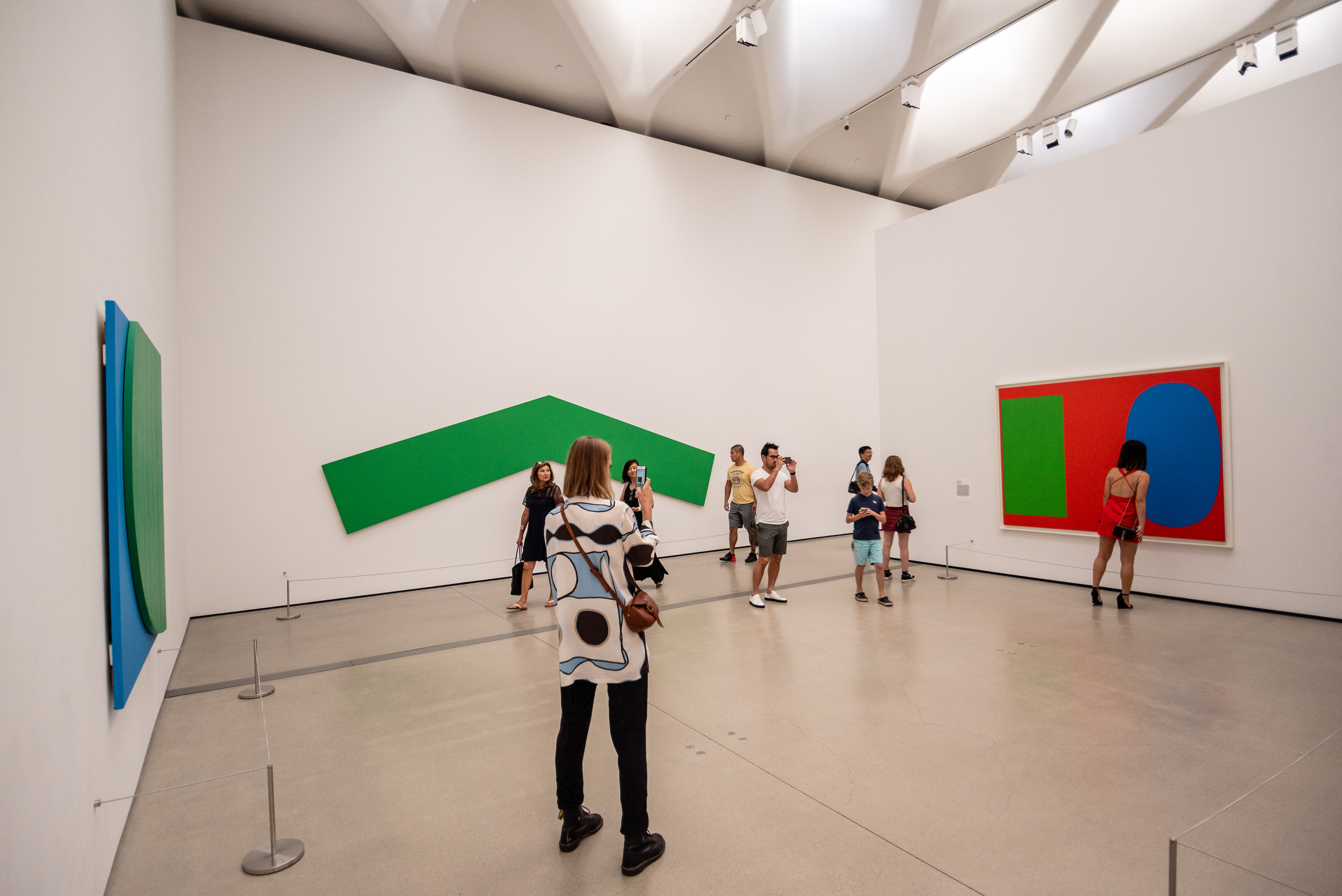

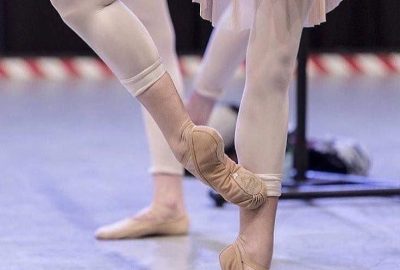
One thought on “Concerning the Spiritual in Art”